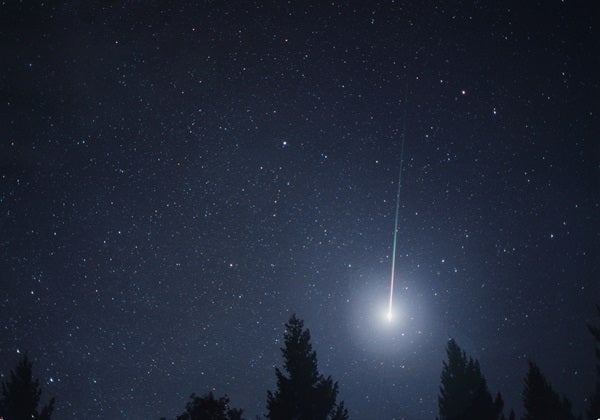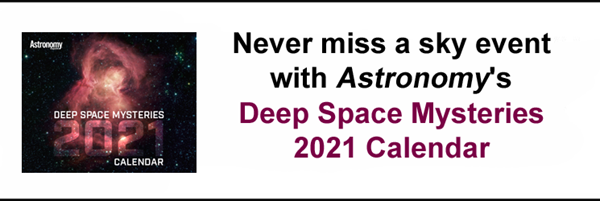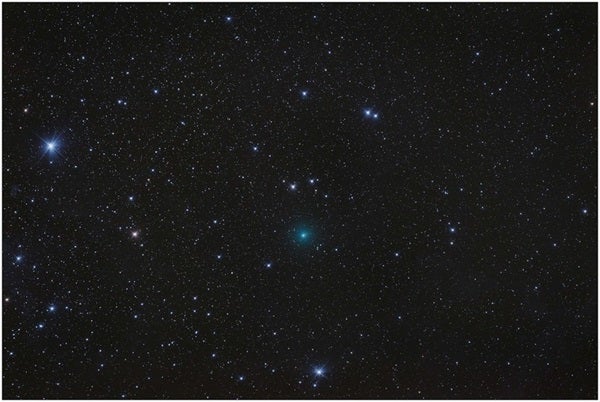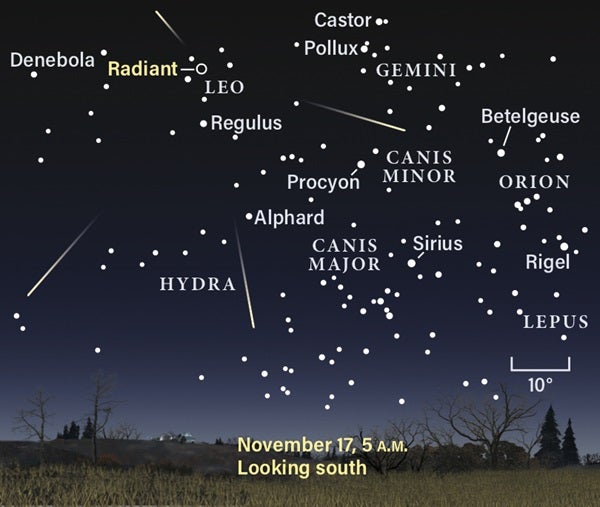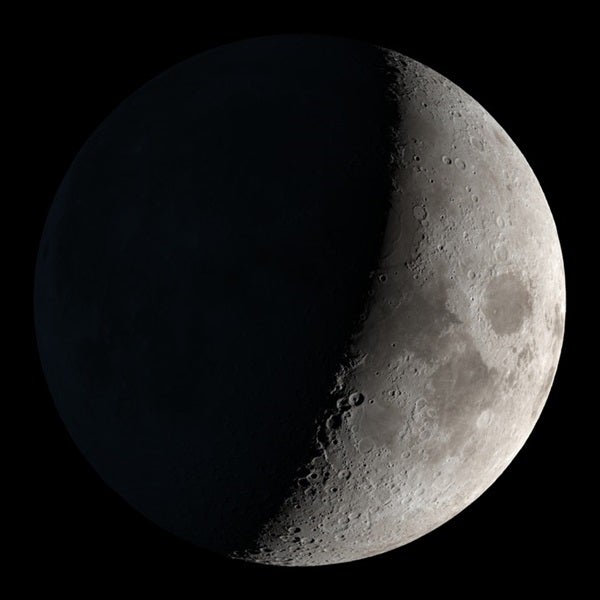The Moon passes 4° north of Mercury at 4 P.M. EST; although you won’t be able to spot the pair after sunset, you can catch them early tomorrow morning before sunrise. Mercury’s days as a morning planet are numbered; by the end of this month it will no longer be visible, although the planet will reappear in the evening sky in late December.
With no Moon in the sky tonight, it’s a great time to check out some deep-sky treasures. Consider one of the finest in the Northern Hemisphere: the Orion Nebula (M42). Visible to the naked eye from a dark site as a fuzzy patch below Orion’s belt, this magnitude 3.7 nebula is one of the closest stellar nurseries to Earth. Binoculars will begin to bring out its detail, while a telescope will offer an even more stunning view. The nebula spans roughly 85′ by 60′ and contains the Trapezium, a group of several bright stars. You’ll spot four through a three-inch scope, while a six-inch instrument or larger will bring out the other two. These young, bright stars are blasting out radiation at a high rate, carving out a region within the nebula’s gas. You can see this clearly as an absence of glowing material immediately around these stars.
Sunrise*: 6:34 A.M.
Sunset: 4:45 P.M.
Moonrise: 4:33 A.M.
Moonset: 4:05 P.M.
Moon Phase: Waning crescent (3%)
*Times for sunrise, sunset, moonrise, and moonset are given in local time from 40° N 90° W. The Moon’s illumination is given at 12 P.M. local time from the same location.
The Moon reaches perigee, the closest point in its orbit to Earth, at 6:43 A.M. EST. Our satellite will sit just 222,350 miles (357,838 kilometers) away. This morning, you can catch Mercury and Venus in Virgo; both planets are well above the horizon an hour before sunrise, with magnitude –4 Venus about 17° high and magnitude –0.7 Mercury a mere 6° high. By 50 minutes before sunrise, the Moon is starting to clear the horizon, now just over 9° east-southeast of Mercury. Our satellite is a mere 0.9 percent lit at this point — can you make it out? Take care if you’re searching with binoculars or a telescope, and set an alarm to go off several minutes before sunrise to avoid risking your eyesight by accidentally catching a glimpse of the Sun through the optics.
But the biggest astronomy event today is much closer to home: NASA’s planned Crew-1 launch from the Kennedy Space Center in Florida, scheduled for 7:49 P.M. EST. The mission will carry four astronauts to the International Space Station and is only the second crewed launch from American soil in years, following the success of the Demo-2 mission earlier this year.
You can watch the launch Live on NASA TV below:
Sunrise: 6:45 A.M.
Sunset: 4:44 P.M.
Moonrise: 5:51 A.M.
Moonset: 4:39 P.M.
Moon Phase: Waning crescent (0.4%)
New Moon occurs this morning at 12:07 A.M. EST, while Venus passes 4° north of Virgo’s brightest star, magnitude 1 Spica, at 8 A.M. EST. You can catch the bright pair this morning in east, starting about 2.5 hours before sunrise.
Mars stands stationary in Pisces at 2 P.M. EST. The Red Planet will now begin moving northeast against the background stars, headed past Epsilon (ε) Piscium early next month and streaking toward Aries the Ram.
Additionally, today marks the closest pass of Comet C/2020 M3 (ATLAS) to Earth, when the comet will come within 0.4 astronomical units. (One astronomical unit is the average Earth-Sun distance.) Rising in the east a few hours after the Sun sets is Orion the Hunter. ATLAS is currently located just 0.5° northeast of Bellatrix (Gamma [γ] Orionis), Orion’s magnitude 1.6 left shoulder. The Comet Observation database reports ATLAS holding steady around magnitude 8, with the best visibility early in the morning — so you may want to start late and follow the comet into tomorrow. Its coma is currently just under 8′ across.
With a period of nearly 140 years, ATLAS won’t be back until 2159, so now is the time to catch it.
Sunrise: 6:46 A.M.
Sunset: 4:43 P.M.
Moonrise: 7:09 A.M.
Moonset: 5:19 P.M.
Moon Phase: Waxing crescent (0.5%)
Monday, November 16
Although now well past its October opposition, Mars remains an excellent evening target. High in the sky after dark, the Red Planet is currently magnitude –1.6 and spans 17″. It will shrink by 2″ during the last two weeks of the month, so get in your observations now. Close study will also show the planet is not quite full — it’s currently 95 percent lit, and will wane slightly to close out November at 92 percent lit.
Amid the faint stars of Pisces, Mars should be the brightest (and reddest) object in that region of sky. Skip northeast to Aries and you’ll find blue-gray Uranus, currently magnitude 5.7 and an easy binocular object. Its 4″-wide disk sits a little less than 3° southeast of 19 Arietis, which matches the planet in brightness. Return to the region night after night and you might see the planet slowly inch toward the star, closing out the month just 2.5° from the luminary.
Sunrise: 6:47 A.M.
Sunset: 4:42 P.M.
Moonrise: 8:26 A.M.
Moonset: 6:06 P.M.
Moon Phase: Waxing crescent (3%)
The Leonid meteor shower peaks early this morning with projected rates of 15 meteors per hour. With the Moon out of the way, the show should put on a good display. The best views will come between 3 A.M. and 6 A.M. local time.
You’ll find the Leonids’ radiant 3.5° northwest of the bright (magnitude 2) star Algieba in Leo the Lion. About 10° directly south of the radiant is the Lion’s brightest star, Regulus. The Leonids are fast-moving meteors and often show persistent trains of ionized gas that can hang in the sky for several seconds after a meteor passes overhead. This shower results from debris left by Comet 55P/Tempel-Tuttle, whose last visit to the inner solar system occurred in 1998. Its next perihelion, or close pass of the Sun, will be in 2031.
Sunrise: 6:48 A.M.
Sunset: 4:42 P.M.
Moonrise: 9:39 A.M.
Moonset: 7:00 P.M.
Moon Phase: Waxing crescent (9%)
Wednesday, November 18
Dwarf planet 1 Ceres is gliding beneath the Helix Nebula (NGC 7293) in Aquarius this week. Tonight, you can spot the magnitude 8.7 world in binoculars or a small scope as it hovers just 1° south of this favorite deep-sky object, which glows at roughly magnitude 7. Wait until after moonset for the best views, but don’t wait too long — the pair will set around 11:30 P.M. local time.
Despite the name, planetary nebulae have nothing to do with planets. Instead, they are Sun-like stars in the last stages of their lives, puffing away the outer layers of their atmosphere as gauzy, glowing gas, while a compact white dwarf (once the star’s core) remains at the center of the nebula. The Helix stretches nearly three light-years across and lies about 650 light-years away, making it one of the closest such objects to Earth.
Sunrise: 6:49 A.M.
Sunset: 4:41 P.M.
Moonrise: 10:42 A.M.
Moonset: 8:01 P.M.
Moon Phase: Waxing crescent (17%)
Thursday, November 19
The Moon passes 2° south of Jupiter at 4 A.M. EST, then skims 3° south of Saturn at 10 A.M. EST. Both occur after the planets have set, however; instead, catch the scene this evening as darkness falls. The Moon is 5.5° southeast of Saturn and 12.2° east-southeast of Jupiter an hour after sunset.
At that time, Jupiter’s moon Callisto is crossing the planet’s face; it’s roughly halfway through its journey, which will take two more hours to complete. Meanwhile, Ganymede slips out from Jupiter’s shadow around 7:13 P.M. EST, reappearing to the planet’s east. Io lies further east, while Europa is visible to Jupiter’s west.
Jupiter and Saturn shine from northeastern Sagittarius, but the Moon has already crossed into Capricornus. Saturn glows at magnitude 0.6, while Jupiter is a brighter magnitude –2.1. The planets themselves appear just over 3° apart, and there’s only a little more than a month to wait for their upcoming Great Conjunction December 21.
Sunrise: 6:50 A.M.
Sunset: 4:40 P.M.
Moonrise: 11:36 A.M.
Moonset: 9:06 P.M.
Moon Phase: Waxing crescent (26%)
Early evening observers should consider taking some time to enjoy the Moon tonight. Our satellite sits smack dab in the middle of Capricornus the Sea Goat, east of Sagittarius (and Jupiter and Saturn).
Easily visible on the Moon’s face is the small, round Mare Crisium, as well as Mare Fecunditatis and Mare Nectaris. Through a telescope, look for the crater Theophilus, which has a prominent central mountain comprising three peaks that rise just over a mile (2 km) above the crater floor. Planetary scientists have dated the crater to sometime between 3 billion and 1 billion years ago, during an era known as the Moon’s Eratosthenian period. Tonight, the crater should appear in sharp relief just to the right of the terminator (the line that divides lunar night from day).
Sunrise: 6:51 P.M.
Sunset: 4:40 P.M.
Moonrise: 12:19 P.M.
Moonset: 10:11 P.M.
Moon Phase: Waxing crescent (36%)
Sky This Month.

